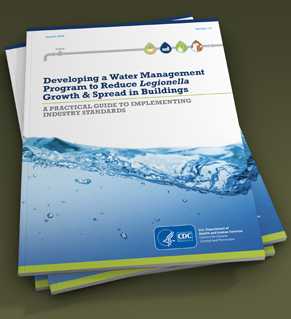Water System Maintenance
The key to preventing Legionnaires’ disease is to prevent Legionella colonization (growth) in water systems. This page offers information for routine maintenance of building and recreational water systems for the prevention of disease.
Building Owners and Managers
Guidelines for reducing the risk of Legionella growth and spread are available for those who maintain and manage building water systems, including systems for potable (water for drinking and showering), non-potable, and recreational water from ASHRAE®. ASHRAE is a not-for-profit organization that develops standards and guidelines for industries that design, manufacture, and maintain building systems.
CDC Seeks Comments on Water Management Programs
CDC is seeking information on effective methods for achieving implementation of water management programs intended to reduce Legionella growth and transmission in buildings at increased risk. Formal comments can be submitted until October 17, 2017.
View the docket and submit comments at the Federal Register.
- ASHRAE Standard 188: Legionellosis: Risk management for building water systems (ANSI approved)
-
Frequently Asked Questions: ASHRAE Standard 188
Get the answers to frequently asked questions about ASHRAE Standard 188, which outlines a minimum legionellosis risk management program for buildings. - ASHRAE Guideline 12-2000: Minimizing the risk of legionellosis associated with building water systems
CDC developed a toolkit to help building owners and managers better understand ASHRAE Standard 188 and how to develop a water management program to reduce the risk of Legionella growing and spreading in their building(s). The first step is determining if your building or certain devices in your building need a water management program. Use this quick yes/no worksheet to find out. If so, learn more about developing a Legionella water management program.
Operating Public Hot Tubs

Developing a Water Management Program to Reduce Legionella Growth and Spread in Buildings
This toolkit provides practical guidance on how to implement industry standards by identifying areas or devices in buildings where Legionella might grow or spread to people so that risk can be reduced through effective water management.
Low water volumes combined with high temperatures and heavy bather loads make public hot tub operation challenging. The result can be low disinfectant levels that allow the growth and spread of a variety of germs (e.g., Pseudomonas and Legionella) that can cause skin and respiratory Recreational Water Illnesses (RWIs). Operators that focus on hot tub maintenance and operation to ensure continuous, high water quality are the first line of defense in preventing the spread of RWIs.
The Model Aquatic Health Code (MAHC) is a voluntary guidance document based on science and best practices that can help local and state authorities and the aquatics sector make swimming and other water activities healthier and safer.
If you are involved in hot tub maintenance, you should
- Obtain state or local authority-recommended operator and chemical handling training. Read a list of national training courses.
- Read and adhere to the Operating Public Hot Tubs fact sheet for pool staff/owners [1 page].
If cases of Legionnaires’ disease or Pontiac fever are linked to a hot tub, it is important to take samples for laboratory testing before disinfecting the hot tub. However, the hot tub should be turned off immediately to prevent more people from getting sick. CDC has a video that walks through the process of collecting water samples from hot tubs for environmental testing. Detailed instructions for disinfecting hot tubs are available on the fact sheet Disinfection of Hot Tubs Contaminated with Legionella [2 pages].
CDC’s Healthy Swimming and Recreational Water website has addition resources related to Pool and Hot Tub Operation.
Working with Legionella Consultants
If your building needs a Legionella water management program or remediation services, you may consider working with one or more Legionella consultants. Learn more about considerations when working with Legionella consultants.
Related Pages
- Preventing Legionnaires’ Disease in Healthcare Facilities, CDC’s Safe Healthcare Blog
- Preventing Legionnaires’ Disease: Environmental Health Expertise Is Key [3 pages]
- What Owners and Managers of Buildings and Healthcare Facilities Need to Know about:
- Healthcare Water Management Program Frequently Asked Questions
- Page last reviewed: June 1, 2017
- Page last updated: October 2, 2017
- Content source:


 ShareCompartir
ShareCompartir